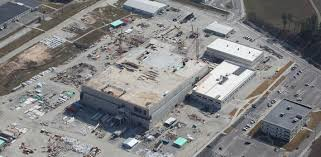In the 1960s, it was estimated that there would be a huge global fleet of nuclear power reactors by the year 2000 that would require reprocessing of spent nuclear fuel in order to create more fuel. As the years passed, interest in nuclear power declined and the world reserves of high grade uranium ore increase. When the year 2000 arrived, the global nuclear power reactor fleet turn out to be one tenth of the early estimate and there was sufficient uranium fuel available. Reprocessing of spent fuel to make more fuel is much more expensive than mining and refining uranium. However, there are indications that world uranium production has peaked and that there may be supply problems in the near future. This has spurred renewed interest in breeder reactors and reprocessing with Russia working on a new generation of breeder reactors and reprocessing plants.
In 1999, the U.S. Nuclear Security Administration (NNSA) signed a contract with what is now Shaw Areva MOX Services, LLC. (SAMS). Under the contract, SAMS would design, build and operate a Mixed Oxide (MOX) Fuel Fabrication Facility (MOFFF). This facility would be used to convert plutonium from nuclear weapons into a form that could be used to fuel U.S. nuclear power reactors. To accomplish this, the plutonium would be mixed with uranium oxide to form the fuel pellets used in nuclear reactors. The design would be based on AREVA's MOX conversion plants in France. The facility was to be constructed at the Savannah River Site operated by NNSA. Under the design, when operational, the facility should be able to convert three and one half metric tons of plutonium into MOX fuel per year.
Currently, most MOX conversion of spent nuclear fuel to recover plutonium is done in the United Kingdom and France with some conversion going on in Russia, India and Japan. China has expressed interest in fast breeder reactors and MOX conversion. With concerns about the world supply of uranium declining, continued use of nuclear power reactors may require increase reprocessing of spent nuclear fuel as well as the use of fast breeder reactors to create plutonium which can then be converted into MOX fuel.
After years of problems at the MOFFF including delays and cost increases, the Obama Administration has decided to halt work on the facility. It was estimated that the reprocessing plant might cost as much as thirty billion dollars over its lifetime. The facility will be put on "cold standby" while the Administration investigates other ways of disposing of or reprocessing spent nuclear fuel from U.S. reactors. Japan has also had a lot of problems with the reprocessing facility that they are working on.
While the intent of MOX creation from weapons grade plutonium is to reduce the amount of weapons grade plutonium in the world, critics have pointed out that during the processing stage, there is an increased risk of theft. There is also the fear that wide use of MOX conversion technology to recover plutonium from spent nuclear fuel which would result in an increase instead of a decrease in the world supply of high grade plutonium, at least during processing. This increases the threat of nuclear proliferation.
MOX Fuel Fabrication Facility at Savannah River Site in South Carolina:
